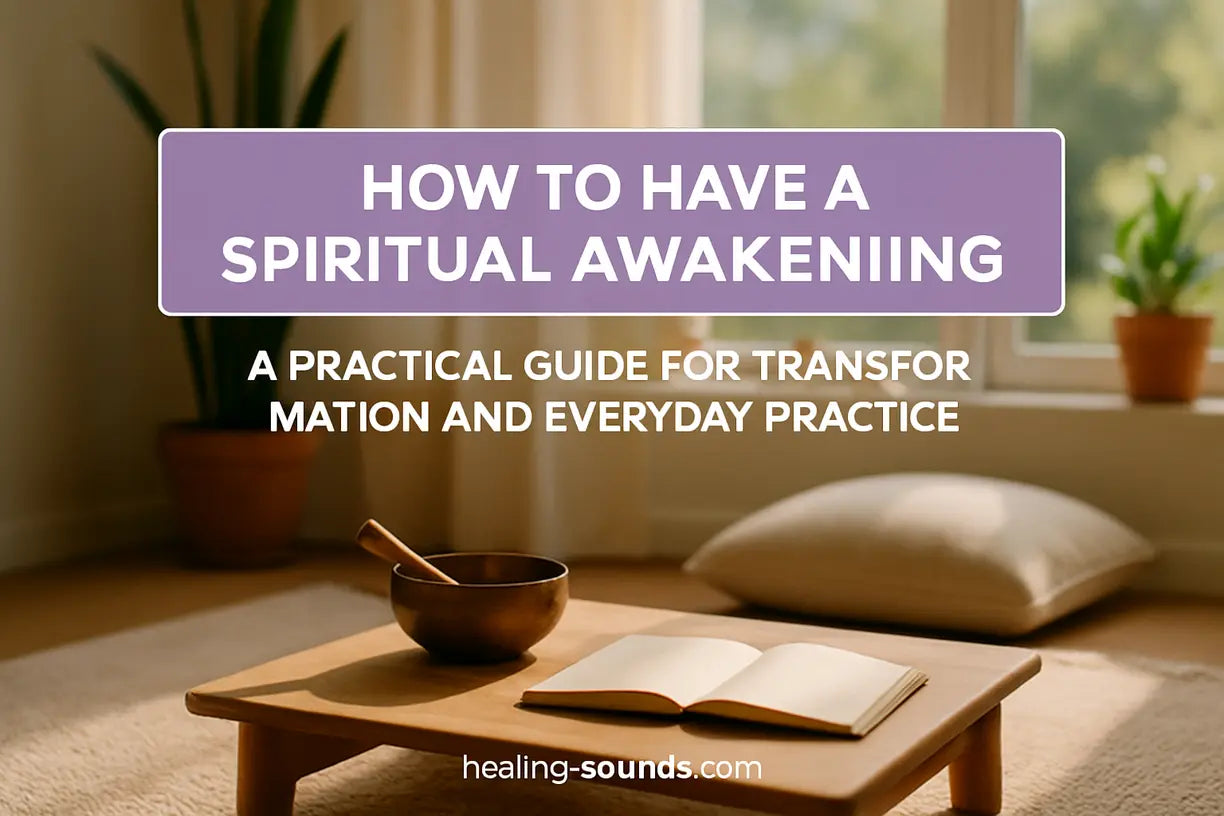Do you feel a gentle yet persistent pull toward something deeper in your life? A sense that there's more to your existence than the daily routine? This feeling is often the first whisper of a spiritual awakening. Embarking on this path can feel both exciting and overwhelming, but you're not alone. This guide is designed to help you understand how to have a spiritual awakening by offering practical, gentle steps and tools to illuminate your journey of personal transformation.
A spiritual awakening isn't a destination to be reached overnight; it's a gradual unfolding of your true, authentic self. It is a profound process of shifting your perspective from a purely material worldview to one that embraces a deeper connection with the universe, your soul, and everything around you. In this article, you'll discover actionable steps, learn to recognize the signs, and find supportive tools to help you navigate this beautiful and life-changing experience with clarity and confidence.
Understanding the Spiritual Awakening Journey
At its core, a spiritual awakening is the process of becoming aware of a reality beyond the ego and the physical world. It's an inner evolution that can be triggered by major life events, deep personal reflection, or a simple, unshakeable curiosity about life's bigger questions. While the experience is unique to each individual, it generally involves shedding old layers of conditioning and limiting beliefs to connect with your higher consciousness. It's a journey of remembering who you truly are. Embracing this process requires patience, self-compassion, and an open heart, allowing you to move through its stages with grace.
The Core Steps to Initiate Your Spiritual Awakening
Starting your spiritual awakening journey is about creating space for your inner self to emerge. It doesn’t require drastic changes, but rather a series of intentional practices that invite awareness and connection into your daily life. Here are the fundamental steps to begin.
Step 1: Cultivate Stillness and Mindfulness
The first step is to quiet the external noise so you can hear your inner voice. Mindfulness is the practice of being fully present in the moment without judgment. This can be achieved through meditation, deep breathing exercises, or simply paying close attention to your senses during everyday activities. Regular practice helps reduce stress, increase clarity, and create the mental space necessary for spiritual insights to arise. Even five minutes of quiet sitting each day can create a powerful shift in your awareness.

Step 2: Practice Deep Self-Inquiry and Journaling
A spiritual awakening invites you to ask profound questions: Who am I without my job title, my roles, or my relationships? What are my deepest values and desires? Journaling is a powerful tool for this exploration. It provides a safe space to process thoughts, confront fears, and track your growth. There are no rules; simply write what comes to mind. This act of translating internal stirrings into written words can reveal patterns and truths you weren't consciously aware of.
Step 3: Connect with Nature
The natural world is a profound teacher and healer. Spending time in nature helps ground your energy and reminds you that you are part of a vast, interconnected web of life. Whether it's a walk in the forest, sitting by the ocean, or tending to a plant on your windowsill, this connection can be deeply restorative. Notice the rhythm of the seasons, the resilience of plants, and the vastness of the sky. This practice helps dissolve feelings of separation and fosters a sense of belonging and peace.

Step 4: Explore Healing Modalities and Tools
As you awaken, you may feel drawn to various healing practices that support your energy and well-being. This can include sound healing, energy work like Reiki, or working with crystals. These modalities are not magic fixes but are powerful aids that can help you clear energetic blockages, raise your vibration, and deepen your spiritual connection. For example, using an amethyst crystal during meditation can help calm the mind and enhance intuition, making it a wonderful companion for your journey.

Amethyst Crystal Tower for Focus and Meditation
$29.99 $39.99
Enhance your spiritual awakening journey with this amethyst tower, perfect for meditation and calming the mind.
Explore ProductStep 5: Embrace Letting Go and Surrender
One of the most crucial and challenging steps in the spiritual awakening process is learning to let go. This means releasing attachments to specific outcomes, forgiving past hurts (both from others and yourself), and surrendering the need to control everything. This practice, often explored in psychological and mindfulness fields, is about trusting the flow of life and having faith that you are being guided. According to research published by institutions like the American Psychological Association, the act of forgiveness and letting go has profound benefits for mental and emotional well-being, which is a cornerstone of spiritual growth.
Essential Tools for Your Spiritual Awakening Toolkit
While the awakening journey is internal, certain external tools can provide focus, comfort, and support. Creating a small collection of sacred items can help you establish rituals and anchor your intentions. Think of these not as necessities, but as helpful allies on your path.

Your personal toolkit might include:
- A Journal and Pen: For self-inquiry and tracking your journey.
- Healing Crystals: Like Amethyst for intuition or Rose Quartz for self-love.
- Smudging Supplies: Such as sage or palo santo to cleanse your space and energy.
- Sound Healing Instruments: A crystal singing bowl or tuning forks can create vibrations that calm the nervous system and align your chakras.
- Inspiring Books: Spiritual texts or memoirs that resonate with your path.
These tools can help you create simple, meaningful rituals. For instance, starting your day with a few minutes of sound healing from a crystal singing bowl can set a peaceful tone, while using a smudge kit to cleanse your space can mark a fresh start and clear stagnant energy. These practices anchor your spiritual commitment in the physical world.
Enhance Your Awakening Journey with These Tools

B Note Amethyst Gemstone Fusion Crystal Singing Bowl
$349.99
$419.99
Deepen your awakening experience with soothing sound healing—ideal for meditation and crown chakra alignment. Learn more ➔
Navigating the Path with Wisdom
A spiritual awakening is not always blissful. It can involve periods of confusion, emotional intensity (sometimes called spiritual awakening symptoms), and feeling isolated. It's vital to navigate these moments with wisdom and grace. Hearing from experienced teachers can provide immense comfort and perspective during these times.
The most important practice during challenging moments is radical self-compassion. Treat yourself with the same kindness you would offer a dear friend. Leading researchers like Dr. Kristin Neff emphasize that self-compassion involves recognizing our shared humanity—acknowledging that suffering and imperfection are part of life for everyone. Remember that you are exactly where you need to be. Trust the process, be patient with your growth, and celebrate the small shifts in awareness along the way.
Your Journey Begins Now
Knowing how to have a spiritual awakening is less about following a rigid formula and more about cultivating a loving, curious relationship with yourself and the world. It begins with a single step: a moment of mindfulness, a question journaled, or a walk in nature. Each intentional act creates a ripple effect, deepening your connection to your true self.
Embrace the journey with an open heart. Use the steps and tools in this guide as a starting point to discover what resonates most deeply with you. Your spiritual awakening is a unique and sacred path unfolding perfectly for you. We invite you to explore our collections of healing crystals, sound bowls, and ritual kits to find the perfect companions to support your beautiful transformation.
Frequently Asked Questions about Spiritual Awakening
A spiritual awakening can be triggered by a wide range of experiences. Common triggers include major life events like the loss of a loved one, a career change, or a health crisis. It can also be sparked by deep feelings of dissatisfaction, extensive travel, meeting a significant person, or engaging in practices like meditation, yoga, or deep self-reflection.
A spiritual awakening is not a finite event with a set timeline; it is an ongoing, lifelong process of growth and evolution. While there may be initial intense periods of awakening that last for months or even a few years, the journey of integrating these new awarenesses and continuing to expand your consciousness continues indefinitely. There is no finish line.
Signs of being on a spiritual awakening path include a heightened sense of intuition, a deeper feeling of connection to others and nature, increased empathy and compassion, a loss of interest in superficial pursuits, a craving for meaning and purpose, and experiencing more synchronicities. You may also feel a greater sense of inner peace and a reduced fear of death.
Spiritual awakening can be blocked by several factors, including a strong attachment to the ego and material possessions, unresolved emotional trauma and suppressed feelings, limiting beliefs and rigid thinking, fear of change or the unknown, and a lack of self-care. Living in a constant state of stress and distraction without creating space for stillness can also be a significant obstacle.
While models vary, a common framework for the stages of spiritual awakening includes: 1) The Trigger or 'The Call,' 2) Questioning and Confusion (often called 'The Dark Night of the Soul'), 3) Exploration and Seeking, 4) Glimpses of a New Reality and Finding Answers, and 5) Integration, where you begin to live from this new, expanded state of consciousness in your daily life.











